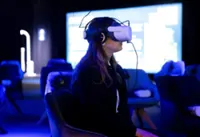The Playstation VR2 on display at the CES tech show in Las Vegas. Sony halved its forecast for shipments of the PSVR2, which is set for a Feb 22 release, this quarter to about a million units, said people familiar with its deliberations. — AP
Sony Group Corp reduced projections for the initial launch of its PlayStation VR2 headset dramatically after early pre-orders disappointed, signalling little improvement for the hyped-but-unproven virtual reality sector.
The company halved its forecast for shipments of the PSVR2, which is set for a Feb 22 release, this quarter to about a million units, said people familiar with its deliberations. Sony had previously aimed to have two million headsets ready for the launch quarter and leverage its second-generation headset to drive user growth and adoption for VR.
Already a subscriber? Log in
Save 30% OFF The Star Digital Access
Cancel anytime. Ad-free. Unlimited access with perks.





